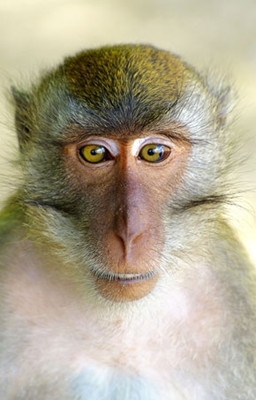科學(xué)技術(shù)
Health indicators
健康指標(biāo)
On the face of it
從表面判斷
More evidence that symmetrical features indicate good health
更多證據(jù)表明對(duì)稱容貌顯示身體健康
BEAUTY may be in the eye of the beholder, but a symmetricalface is usually a big help.
情人眼里出西施,但對(duì)稱的容貌通常有助于美感。
 In contrast, asymmetry is often associated with malignance.
In contrast, asymmetry is often associated with malignance.
相反,非對(duì)稱通常與丑惡相聯(lián)。
Biologists have long speculated why this is.
生物學(xué)家長(zhǎng)期思考為什么會(huì)出現(xiàn)這種情況。
In theory, evolution provides a logical answer: unfit individuals are less likely than fitter folk to be able to maintain the symmetrical development of their bodies when exposed to stress and disease.
就理論上而言,進(jìn)化論就是其邏輯答案。在面臨壓力與疾病時(shí),非健康者可能不如健康者能保持自身的對(duì)稱發(fā)展。
In other words, many parts of the body are supposed to be symmetrical, so any deviation from perfect symmetry indicates that an animal has not been able to grow as intended.
換句話說,身體的許多部位本是對(duì)稱的,那么,從完美對(duì)稱變?yōu)榉菍?duì)稱表明身體已不可能按正常發(fā)展。
As an animal is unlikely to want to mix its genes with an unfit or diseased partner, evolution selects symmetry as an attractive trait.
由于健康者不大可能愿意其基因與非健康/患病者的相結(jié)合,進(jìn)化論便選擇對(duì)稱作為一個(gè)有吸引力的特征。
Whether asymmetry and poor health or fitness really go hand in hand has not been easy to prove.
很難證明非對(duì)稱者是否與非健康或健康真正相關(guān)聯(lián)。
Research on this in humans causes ethical problems and can raise hackles.
關(guān)于人類這個(gè)問題的研究導(dǎo)致種簇問題,造成憤怒。
Now a new study conducted with macaque monkeys hints that there is indeed a connection.
現(xiàn)在,以獼猴為例的一項(xiàng)新的研究表明他們的確有關(guān)聯(lián)。
Previous studies with macaques have demonstrated that the animals will gaze longer at symmetrical faces than they do at asymmetric ones, which could be interpreted as the monkeys finding such faces more attractive.
先前有關(guān)獼猴的研究實(shí)驗(yàn)表明,相比非對(duì)稱性獼猴,獼猴愿意花更多長(zhǎng)凝視擁有對(duì)稱性容貌的獼猴,這可能理解為獼猴發(fā)現(xiàn)那些具有對(duì)稱性容貌的具有更多吸引力。
The results of these studies have led researchers to believe that the monkeys have a preference for symmetry just as humans do.
研究結(jié)果使得研究者相信獼猴與人類一樣偏愛對(duì)稱性容貌者。
However, a clear connection between health and symmetry had not been made.
然而,健康與對(duì)稱性的關(guān)聯(lián)還未得到確切的證明。
Fascinated by this question, Anthony Little of the University of Stirling in Scotland and Annika Paukner of the National Institutes of Health in America established a new study with 93 female macaque monkeys.
受這個(gè)問題的困擾,蘇格蘭斯特林大學(xué)的安東尼.里特與美國(guó)國(guó)立衛(wèi)生研究院的安妮卡.波克恩一起對(duì)93只獼猴進(jìn)行一項(xiàng)新的研究。
The monkeys came from three different groups and had been raised in some degree of captivity.
這些獼猴來自三個(gè)不同群組,受到不同程度的圈養(yǎng)。
All of the monkeys, between the ages of five and 20, were photographed, face forward.
所有這些獼猴年齡都在5歲-20歲,他們面朝前面一起接受拍照。
Dr Little and his colleagues analysed facial symmetry using a computer to measure the distance of various features, like the edges of the nostrils, lips and eyes, from a line drawn down the centre of the monkey's face.
一條中間直線劃分獼狒面部,里特博士和他的同事使用電腦測(cè)量不同器官的兩邊距離,包括鼻孔,嘴唇,眼睛。
These distances were then compared and any differences between them were added to an overall asymmetry score.
然后,對(duì)這些測(cè)量的距離進(jìn)行對(duì)比,把所有的差距匯總,就成了非對(duì)稱數(shù)據(jù)。
Thus a perfectly symmetrical face, with eyes, lips and nostrils exactly the same distance from the central line, would earn a score of zero.
因此,非常完美的對(duì)稱面貌,眼睛,嘴唇以及鼻子兩邊離中間線的距離是相同的,因而總對(duì)稱分?jǐn)?shù)為0。
A highly asymmetric one would score the sum of all the distance differences between features on the face.
他們記錄下非常不對(duì)稱的獼猴臉部器官的差距和。
The team then considered the overall health of the monkeys during their first four years of life.
前四年這個(gè)團(tuán)隊(duì)關(guān)注這些獼猴的總體健康。
This comparison was made from veterinary records and evidence of health problems.
他們對(duì)獸醫(yī)記錄的以及健康問題的證據(jù)進(jìn)行對(duì)比。
The researchers looked out for minor wounds that had been noted by staff but left to heal on their own; major wounds such as bites that required stitches; levels of subcutaneous fat and muscle; the quality of their coat; and their weight gain.
研究人員關(guān)注那些工作人員之前注意到卻任其自愈的小傷口;諸如咬傷之類需要縫合的大傷口;因咬而需縫線的大傷口;皮下脂肪厚度,肌肉的強(qiáng)壯;表皮質(zhì)量以及體重增加。
These health factors were compiled into two scores, one reflecting wounds and one reflecting the monkey's general condition, and they were compared with the asymmetry scores.
這些健康因素分成兩組分?jǐn)?shù),一組反映傷口情況,另一組反應(yīng)獼猴總體身體狀況,這些與不對(duì)稱性數(shù)據(jù)進(jìn)行比較。
Dr Little and his colleagues report in Behavioural Ecology and Sociobiology that whereas wounds showed no relationship to asymmetry, as the monkeys' condition scores declined so too did their facial-symmetry results.
里特博士和他同事在《行為生態(tài)學(xué)和社會(huì)生物學(xué)》雜志上報(bào)道:雖然傷口與不對(duì)稱性無任何關(guān)系,但猴子身體狀況越差,它們的臉部就越不對(duì)稱。
The researchers argue that this health connection is what makes macaque monkeys look longer at symmetrical faces than they do at uneven ones.
這些研究員認(rèn)為,這一健康關(guān)聯(lián)是因?yàn)楂J猴對(duì)著對(duì)稱面貌比不對(duì)稱面貌時(shí)間長(zhǎng)。
Thus facial symmetry really does appear to be an indicator of health, at least among macaques.
因此,面貌對(duì)稱性真正能呈現(xiàn)身體健康指標(biāo),至少獼猴是這樣。
And what is true for them is likely to be true for people too.
因此,適用于獼狒的這一原理可能也適用于人。
 In contrast, asymmetry is often associated with malignance.
In contrast, asymmetry is often associated with malignance.
 In contrast, asymmetry is often associated with malignance.
In contrast, asymmetry is often associated with malignance.